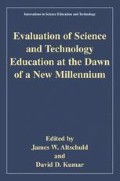Access this chapter
Tax calculation will be finalised at checkout
Purchases are for personal use only
Preview
Unable to display preview. Download preview PDF.
References
Apple University Arts. (1999, Spring). Introductory meteorology courses transformed by the web. [Available on-line: http://www.apple.com/education/hed/aua0101s/meteor]
Burge, E. J. (1994). Learning in computer conferenced contexts: The learners’ perspective. Journal of Distance Education 9:19–43.
Charp, S. (2000). The role of the Internet. T.H.E. Journal 27:8–9.
Clark, R. E. (1983). Reconsidering research on learning from media. Review of Educational Research 53:445–459.
Collins, M. (1997). Developing and running a WWW biology course. The American Biology Teacher 59:594–596.
Curriculum Administrator’s Schooltone Magazine. (2000, March). Verbatim, John Gage: Technology made easy. Part II of II, pp. 4–5.
Doolittle, P. E. (1999). Constructivism on-line. 1999 On-line Conference on Teaching On-line in Higher Education. [Available on-line: http://www.tandl.vt.edu/doolittle/tohe/on-line.html]
Edelson, P. J. (1998, February 17). The organization of courses via the Internet, Academic aspects, interaction, evaluation, and accreditation. Paper presented at the National Autonomous University of New Mexico, Mexico City.
Fraser, A. B. (1999). Colleges should tap the pedagogical potential of the World-Wide Web. [Available on-line: http://www.apple.com/education/hed/aua0101s/meteor]
Gregor, S. D., and Cuskelly, E. F. (1994). Computer mediated communication in distance education. Journal of Computer Assisted Learning 10:168–181.
Hara, N., and Kling, R. (2000). Students’ distress with a web-based distance education course. Bloomington, IN: The Center for Social Informatics, Indiana University. [Available online at: http://www.slis.indiana.edu/CSI/wp00-01.html]
Ingebritsen, T. S., and Flickenger, K. (1998). Development and assessment of web courses that use streaming audio and video technologies. Iowa State University. (ERIC Document Reproduction Service No. ED 422 859)
Institute for Higher Education Policy. (1999, April). What’s the difference? A review of contemporary research on the effectiveness of distance learning in higher education. University of Pennsylvania. [Available on-line: http://www.ihep.com/PUB.htm]
Imel. S. (1998). Distance learning. Myths and Realities, ERIC Clearinghouse on Adult, Career, and Vocational Education. [Available on-line: Jonassen, D., Davidson, M., Collins, M.
Campbell, J., and Haag, B. B. (1995). Constructivism and computer-mediated communication in distance education. The American Journal of Distance Education 9:7–26.
Kang, I. (1988). The use of computer-mediated communication: Electronic collaboration and interactivity. In Bonk C. J. and King K. (Eds.), Electronic collaborators: Learner-centered technologies for literacy, apprenticeship, and discourse, Erlbaum, Mahwah, NJ, pp. 315–337.
Holmberg, R. G., and Bakshi, T. S. (1982). Laboratory work in distance education. Distance Education 3:198–206.
Lennex, L. (2000, January). Distance education for newbies. Paper presented at the annual meeting of the Association for the Education of Teachers in Science, Akron, OH. [Available on-line: http://www.ed.psu.edu/CI/Journals/2000AETS/00file1.htm]
National Center for Education Statistics. (1997). Distance education in higher education Institutions. Post secondary Education Quick Information System. U.S. Department of Education. [Available on-line: http://nces.ed.gov/pubs99/condition99/indicator-31.html]
National Science Education Standards. (1996). National Academy Press. Washington. DC.
Rekkedal, T. (1994). Research in distance education-past, present, and future. NKI Foundation, Norway. [Available on-line: http://www.nettskolen.com/alle/forskning/29/intforsk.htm]
Russell, T. L. (1999). The no significant difference phenomenon. Chapel Hill, NC: Office of Instructional Technologies, North Carolina state University.
Saba, F. S. (1999). Distance education: An introduction. [Available on-line: http://www.distance-educator.com/portals/research_deintro.html]
Schulman, A. H., and Sims, R. L. (1999). Learning in an on-line format versus an in-class format: An experimental study. T.H.E. Journal 26:54–56.
Spector, B. S., Burkett, R., Barnes, M., and Johnson, J. (2000. January). Inter-institutional efforts to develop a web based STS course. Paper presented at the annual meeting of the Association for the Education of Teachers in Science, Akron, OH. [Available on-line: http://www.ed.psu.edu/CI/Journals/2000AETS/00file1.htm]
The Pennsylvania State University. (1999). Distance education catalog. University Park, PA. [Available on-line: http://www.worldcampus.psu.edu]
The University of Phoenix. (2000). The University of Phoenix Home page. [Available on-line: http://www.phoenix.edu/faculty/index.html]
Truman, B. E. (1995, March). Distance education in post secondary institutions and business. Unpublished manuscript. [Available on-line: http://pegasus.cc.ucf.edu/~btruman/dist-lr.html]
Venables, J. A. (1998). Graduate education on the Internet. Physics Education 33:157–163.
Wiesenberg, F., and Hutton, S. (1995, November). Teaching a graduate program using computer mediated conferencing software. Paper presented at the Annual Meeting of the American Association for Adult and Continuing Education, Kansas City, MO.
Author information
Authors and Affiliations
Editor information
Editors and Affiliations
Rights and permissions
Copyright information
© 2002 Kluwer Academic Publishers
About this chapter
Cite this chapter
Cannon, J.R. (2002). Distance Learning in Science Education. In: Altschuld, J.W., Kumar, D.D. (eds) Evaluation of Science and Technology Education at the Dawn of a New Millennium. Innovations in Science Education and Technology, vol 14. Springer, Dordrecht. https://doi.org/10.1007/0-306-47560-X_10
Download citation
DOI: https://doi.org/10.1007/0-306-47560-X_10
Publisher Name: Springer, Dordrecht
Print ISBN: 978-0-306-46749-3
Online ISBN: 978-0-306-47560-3
eBook Packages: Springer Book Archive

